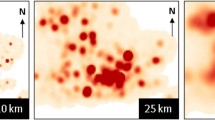Abstract
This paper compared and contrasted patent counts by examining the inventor country and the assignee country. An empirical analysis of the patent data revealed how assignment principles (i.e. by the inventor country and by the assignee county) and counting methods (i.e. whole counts, first country and fractional counts) generate different results. Quadrant diagrams were utilised to present the patent data of the 33 selected countries. When countries had similar patent counts by inventor country with patent counts by assignee country, all the countries allocated along the diagonal line in the quadrant diagram were developed countries. When countries had more patent counts by inventor than by assignee, developed countries were more likely to sit in the right upper section of the quadrant diagram, while more developing countries were situated in the left lower section. Countries with higher patent counts by assignee than by inventor were more likely to be tax havens. A significant contribution of this paper resides in the recommendation that patent counts be analysed using both the inventor country and the assignee country at the same time if meaningful implications from patent statistics are to be obtained.



Similar content being viewed by others
References
Archambault, E. (2002). Methods for using patents in cross-country comparisons. Scientometrics, 54(1), 15–30.
Bergek, A., Bruzelius, M. (2005). Patents with inventors from different countries: Exploring some methodological issues through a case study. The DRUID Tenth Anniversary Summer Conference. Retrieved April 01 2013 from http://www2.druid.dk/conferences/viewpaper.php?id=2694&cf=18.
Cantwell, J. (1989). Technological innovation and multinational corporations. New York: Blackwell Publishers.
Dachs, B., & Ebersberger, B. (2009). Does foreign ownership matter for the innovative activities of enterprises? International Economics and Economic Policy, 6(1), 41–57.
Dachs, B., Ebersberger, B., & Lööf, H. (2008). The innovative performance of foreign-owned enterprises in small open economies. Journal of Technology Transfer, 33, 393–406.
Gao, X., Guo, X., & Guan, J. (2013). An analysis of the patenting activities and collaboration among industry-university-research institutes in the Chinese ICT sector. Scientometrics. doi:10.1007/s11192-013-1048-y.
Gauffriau, M., Larsen, P. O., Maye, I., Roulin-Perriard, A., & von Ins, M. (2008). Comparisons of results of publication counting using different methods. Scientometrics, 77(1), 147–176.
Grupp, H., & Schmoch, U. (1999). Patent statistics in the age of globalisation: new legal procedures, new analytical methods, new economic interpretation. Research Policy, 28(1), 377–396.
Guellec, D., & van Pottelsberghe de la Potterie, B. (2001). The internationalisation of technology analysed with patent data. Research Policy, 30(8), 1253–1266.
Han, Y. J. (2007). Measuring industrial knowledge stocks with patents and papers. Journal of Informetrics, 1(4), 269–276.
Huang, M. H., Dong, H. R., & Chen, D. Z. (2012). Globalization of collaborative creativity through cross-border patent activities. Journal of Informetrics, 6(2), 226–236.
Huang, M., Sung, H., Wang, C., & Chen, D. (2013). Exploring patent performance and technology interactions of universities, industries, governments and individuals. Scientometrics, 96(1), 11–26.
Jaffe, A. B., Trajtenberg, M., & Henderson, R. (1993). Geographic localization of knowledge spill overs as evidenced by patent citations. Quarterly Journal of Economics, 108(3), 577–598.
Lei, X. P., Zhao, Z. Y., Zhang, X., Chen, D. Z., Huang, M. H., Zheng, J., et al. (2013). Technological collaboration patterns in solar cell industry based on patent inventors and assignees analysis. Scientometrics, 96(2), 427–441.
Leiponen, A., Helfat, C. E. (2006). Geographic location and decentralisation of innovative activity. Mimeo. Retrieved April 03 2013 from http://www-old.rhsmith.umd.edu/seminars/pdfs/2006/helfat.pdf.
Lin, C. S., Huang, M. H., & Chen, D. Z. (2013). The influences of counting methods on university rankings based on paper count and citation count. Journal of Informetrics, 7(3), 611–621.
Messinis, G. (2011). Triadic citations, country biases and patent value: The case of pharmaceuticals. Scientometrics, 89(3), 813–833.
Narin, F. (1994). Patent bibliometrics. Scientometrics, 30(1), 147–155.
Narin, F. (2000). Tech-line® background paper. In J. Tidd (Ed.), From knowledge management to strategic competence (pp. 155–195). London: Imperial College Press.
Neuhäusler, P., & Frietsch, R. (2013). Patent families as macro level patent value indicators: Applying weights to account for market differences. Scientometrics, 96(1), 27–49.
Organization for Economic Co-operation and Development (OECD). (2001). Using patent counts for cross-country comparisons of technology output. STI Review, 27. Paris: OECD.
Organization for Economic Co-operation and Development (OECD). (2009). OECD patent statistics manual. Paris: OECD.
Penner-Hahn, J., & Shaver, J. M. (2005). Does international research and development increase patent output? An analysis of Japanese pharmaceutical firms. Strategic Management Journal, 26(2), 121–140.
Schubert, T. (2011). Assessing the value of patent portfolios: An international country comparison. Scientometrics, 88(3), 787–804.
Singh, J. (2008). Distributed R&D, cross-regional knowledge integration and quality of innovative output. Research Policy, 37(1), 77–96.
Stuart, T. E. (2000). Interorganizational alliances and the performance of firms: A study of growth and innovation rates in a high-technology industry. Strategic Management Journal, 21, 791–811.
Trajtenberg, M. (1990). A penny for your quotes: Patent citations and the value of innovations. Journal of Economics, 21(1), 172–187.
Yamin, M., & Otto, J. (2004). Patterns of knowledge flows and MNE innovative performance. Journal of International Management, 10, 239–258.
Zheng, J., Zhao, Z. Y., Zhang, X., Chen, D. Z., & Huang, M. H. (2013). International collaboration development in nanotechnology: A perspective of patent network analysis. Scientometrics. doi:10.1007/s11192-013-1081-x.
Zheng, J., Zhao, Z. Y., Zhang, X., Chen, D. Z., Huang, M. H., Lei, X. P., et al. (2012). International scientific and technological collaboration of China from 2004 to 2008: A perspective from paper and patent analysis. Scientometrics, 91(1), 65–80.
Acknowledgments
The authors thank Dr. David C. McConville, University of Portsmouth, for his kind help with editing this paper.
Author information
Authors and Affiliations
Corresponding author
Rights and permissions
About this article
Cite this article
Sung, HY., Wang, CC., Chen, DZ. et al. A comparative study of patent counts by the inventor country and the assignee country. Scientometrics 100, 577–593 (2014). https://doi.org/10.1007/s11192-013-1192-4
Received:
Published:
Issue Date:
DOI: https://doi.org/10.1007/s11192-013-1192-4




